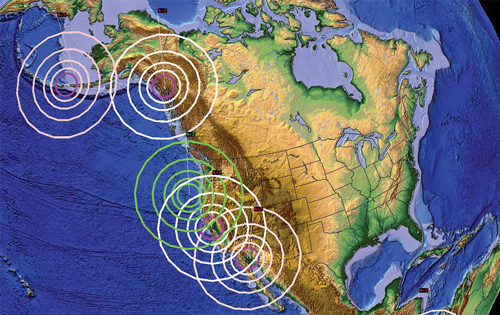What to do when the earth starts rumbling

Imagine driving across the Winchester Bridge, thinking about class, hoping you did the right homework and all of a sudden the bridge starts to rock, sway and shake. None of us expect a natural disaster, and few of us prepare for it. The signs of a serious, potentially dangerous earthquake, however, are everywhere.
Earthquakes are appearing all over the Northwest in sites with dormant volcanoes. On May 28, a swarm of earthquakes developed near a dormant butte, “Cerro Prieto,” near San Diego. A 4.2 magnitude earthquake off the coast of Bandon reportedly shook the entire U.S. West Coast on May 22. A 4.8 magnitude earthquake on May 23 then hit Nevada near Las Vegas. On May 26, a 4.3 earthquake was felt near Ferndale, California as well as a 3.0 near Hamilton City, California. Undersea volcanic activity 300 miles off the coast of Oregon west of Cannon Beach is also concerning scientists. Along the Axial Seamount, a fresh fissure has formed, producing new undersea lava flows and seismic activity, according to earthquake authorities.
How serious is an earthquake in a magnitude near 4? It can feel like a heavy truck striking a building, according to the U.S. Geological Survey, and scientists are predicting an imminent 9.0 strike for the West Coast. According to NBC news, “ No one should be surprised if a magnitude 9 mega quake erupts off America’s West Coast — or anywhere else around the Pacific Ocean’s”Ring of Fire,”for that matter. The 1989 San Francisco earthquake which destroyed freeways, buildings and killed 63 people was only a 6.9.
According to the Ford Family Foundation, the percentage of Oregon schools with a high or very high risk of collapse in a major earthquake is 47 percent. Oregon is at risk for a catastrophic earthquake and tsunami event like the one that hit Japan in 2011, says Josh Bruce, also of the Ford Family Foundation.
Recovering from a large earthquake won’t be easy. The Oregon Resilience Plan reveals the timeframes for service recovery. Just restoring electricity will be daunting (see chart below).
| Critical Service | Zone | Electricity time to restore service |
|---|---|---|
| Electricity | Valley | One to three months |
| Electricity | Coast | Three to six months |
| Police/Fire Stations | Valley | Two to four months |
| Drinking water/sewer | Valley | One month to a year |
| Drinking water/sewer | Coast | One to three years |
| Top-priority highways | Valley | Six to twelve months |
| Healthcare facilities | Valley | Eighteen months |
| Healthcare facilities | Coast | Three years |
The moral is to get prepared with a plan in place. Umpqua Community College’s emergency plan suggests students and staff do the following in an earthquake:
1. During and immediately following an earthquake, take cover under desks, tables, workbenches, etc.
2. Stay clear of glass windows, suspended objects, tall filing cabinets, etc.
3. Remain at your location until the quake subsides. Do not rush to exits, as the hazard of being injured by falling debris or broken utility systems is great.
4. When safe to do so, and if necessary, exit the building and/or campus by the closest safe exit and await instructions.
5. Report injuries, broken utility lines, fires and other hazards to the emergency personnel. If the phones are available, report injuries, broken lines, fires or other hazards to 911.
6. Implement emergency response organization.
Preparing at home is a bit more complex. The Federal Emergency Management Agency (FEMA) suggests the following:
1. Look around places where you spend time. Identify safe places such as under a sturdy piece of furniture or against an interior wall in your home, office or school so that when the shaking starts, you drop to the ground, cover your head and neck with your arms, and if a safer place is nearby, crawl to it and hold On.
2. Practice how to “Drop, Cover, and Hold On!” Practice often. You may only have seconds to protect yourself in an earthquake.
3. Before an earthquake occurs, secure items that could fall and cause injuries (bookshelves, mirrors, light fixtures). Store critical supplies (water, medication) and documents.
4. Plan how you will communicate with family members, including multiple methods by making a family emergency plan.
5. When choosing your home or business, check if the building is earthquake resistant per local building codes.
